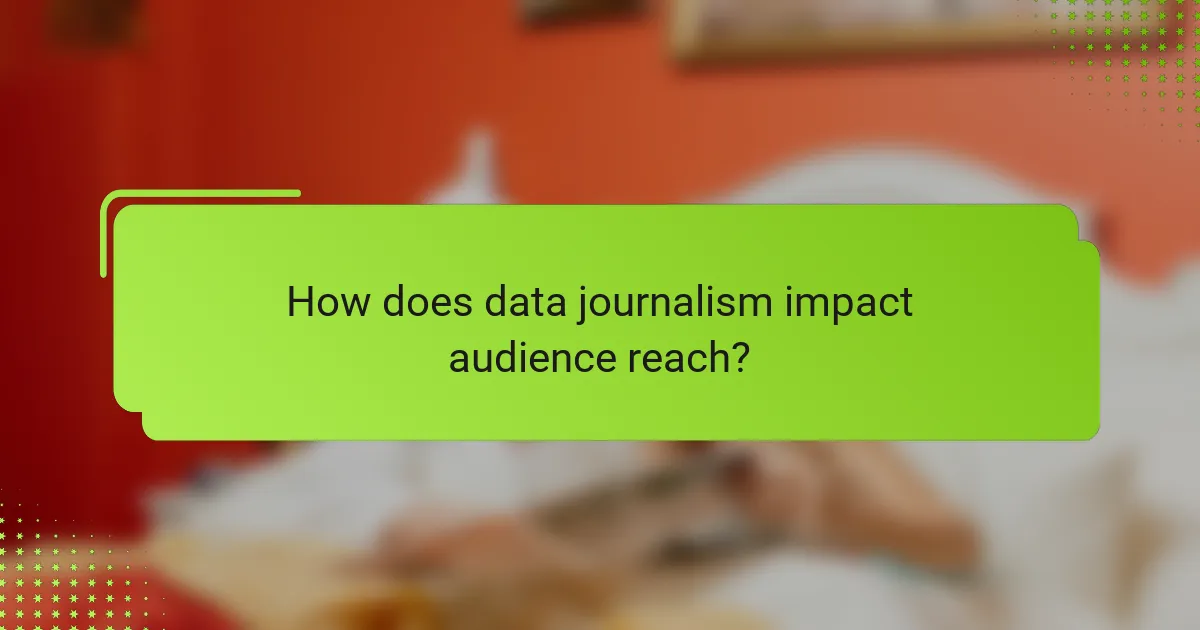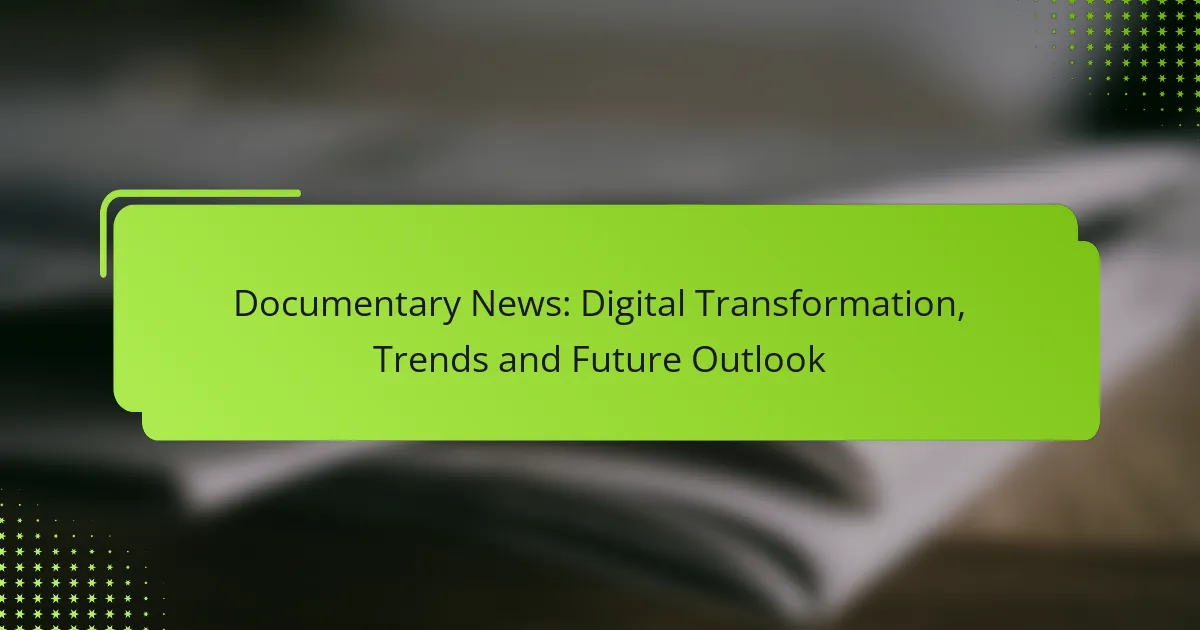Data journalism revolutionizes the way stories are told by weaving quantitative information into narratives, making complex issues more accessible and engaging. By utilizing advanced tools for data visualization and analysis, journalists can transform intricate data into compelling stories that resonate with diverse audiences, ultimately enhancing both production quality and audience reach.

How does data journalism influence storytelling?
Data journalism significantly enhances storytelling by integrating quantitative information into narratives, making them more compelling and informative. This approach allows journalists to present complex issues in a digestible format, engaging audiences through evidence-based insights.
Enhanced narrative techniques
Data journalism improves narrative techniques by providing a structured way to present facts and figures that support the story. Journalists can weave data into their narratives, creating a more engaging experience for readers. For instance, using statistics to highlight trends can transform a simple news article into a powerful commentary on societal issues.
Additionally, incorporating data allows for a multi-layered storytelling approach, where different perspectives can be explored through various datasets. This depth can lead to more nuanced discussions and a better understanding of the subject matter.
Data-driven insights
Data-driven insights are crucial in data journalism as they provide the foundation for informed storytelling. Journalists analyze data to uncover patterns, correlations, and anomalies that might not be immediately visible. For example, examining economic data can reveal the impact of policy changes on local communities, offering readers a clearer picture of real-world implications.
Moreover, these insights can guide editorial decisions, helping journalists focus on the most relevant aspects of a story. By prioritizing data that resonates with the audience, journalists can enhance engagement and relevance.
Visual storytelling elements
Visual storytelling elements play a vital role in data journalism by making complex information more accessible. Charts, graphs, and infographics can distill large amounts of data into easily understandable visuals, allowing readers to grasp key points quickly. For example, a well-designed infographic can illustrate trends in public health data, making the information more relatable and impactful.
Furthermore, effective visual elements can enhance the emotional appeal of a story. By pairing compelling visuals with data, journalists can evoke stronger reactions from their audience, fostering a deeper connection to the narrative. Utilizing tools like interactive maps or dynamic charts can also encourage audience interaction, further increasing engagement.

What are the key tools for data journalism?
Key tools for data journalism include software and platforms that facilitate data visualization, reporting, and statistical analysis. These tools help journalists convert complex data into accessible stories, enhancing audience engagement and understanding.
Tableau for data visualization
Tableau is a powerful tool for data visualization that allows journalists to create interactive and shareable dashboards. It simplifies the process of turning raw data into visual formats like charts and graphs, making it easier for audiences to grasp insights quickly.
When using Tableau, consider the types of visualizations that best represent your data. For instance, use line graphs for trends over time and bar charts for comparing categories. Avoid cluttering visuals with too much information, as simplicity often enhances clarity.
Google Data Studio for reporting
Google Data Studio is a free tool that enables journalists to create customizable reports and dashboards from various data sources. Its integration with Google Analytics and other platforms allows for real-time data updates, making it ideal for ongoing stories.
To maximize the effectiveness of Google Data Studio, focus on clear layouts and relevant metrics. Use filters and date ranges to tailor reports to specific audiences. Remember to share reports easily by providing links or embedding them in articles for broader reach.
R for statistical analysis
R is a programming language widely used for statistical analysis and data manipulation in journalism. It offers a vast array of packages for tasks such as data cleaning, statistical modeling, and generating visualizations, making it a versatile choice for data-driven stories.
When using R, familiarize yourself with its syntax and libraries like ggplot2 for visualization and dplyr for data manipulation. Start with small datasets to practice and gradually work with larger datasets. Be cautious with assumptions in statistical tests to ensure accurate interpretations of your findings.

How does data journalism impact audience reach?
Data journalism significantly enhances audience reach by providing compelling, fact-based stories that resonate with readers. By leveraging data, journalists can create content that is not only informative but also tailored to the interests and needs of specific audiences.
Targeted content creation
Data journalism allows for the creation of targeted content that speaks directly to specific demographics or interest groups. By analyzing data trends, journalists can identify what topics are most relevant to their audience, ensuring that the stories produced are engaging and pertinent.
For example, a news outlet might use demographic data to focus on local issues affecting a particular community, such as housing or education. This approach increases the likelihood of attracting readers who feel a personal connection to the content.
Improved engagement metrics
With data-driven storytelling, media organizations often see improved engagement metrics, such as higher click-through rates and longer time spent on articles. Engaging visuals, like infographics or interactive charts, can make complex data more digestible and appealing to readers.
For instance, articles that incorporate visual data representations can lead to engagement increases of 20-30%, as readers are more likely to share and discuss visually appealing content. This not only boosts individual article performance but also enhances overall brand visibility.
Social media amplification
Data journalism can significantly amplify content on social media platforms, where shareable, data-backed insights often attract attention. Posts that include striking statistics or compelling visualizations are more likely to be shared, increasing their reach exponentially.
To maximize social media impact, journalists should focus on crafting headlines that highlight key data points and use visuals that capture attention. For example, a tweet featuring a striking statistic accompanied by a chart can lead to higher engagement compared to text-only posts.

What are the challenges in data journalism?
Data journalism faces several challenges that can impact the quality and effectiveness of reporting. Key issues include ensuring data accuracy, navigating ethical considerations, and dealing with resource limitations.
Data accuracy issues
Data accuracy is crucial in data journalism, as incorrect information can mislead audiences and damage credibility. Journalists must verify sources and cross-check data against multiple reliable databases or reports.
Common pitfalls include relying on outdated datasets or failing to account for biases in data collection methods. To mitigate these risks, journalists should use data from reputable organizations and stay updated on any changes or corrections to the data.
Ethical considerations
Ethical considerations in data journalism revolve around transparency, privacy, and the potential for misrepresentation. Journalists must disclose their data sources and methodologies to maintain trust with their audience.
Moreover, sensitive data involving individuals or communities requires careful handling to avoid harm. Adhering to ethical guidelines, such as those from the Society of Professional Journalists, can help navigate these challenges effectively.
Resource limitations
Resource limitations can hinder the ability to conduct thorough data journalism. Many news organizations face budget cuts, which can reduce access to advanced data analysis tools or skilled personnel.
To overcome these constraints, journalists can leverage free or low-cost data analysis software and collaborate with academic institutions or non-profits that specialize in data research. Building a network of data-savvy colleagues can also enhance reporting capabilities without significant financial investment.

What are the best practices for data journalism?
Best practices for data journalism involve rigorous data verification, collaborative storytelling, and integrating audience feedback. These practices ensure that the stories told are accurate, engaging, and resonate with the audience.
Data verification methods
Data verification is crucial in data journalism to maintain credibility. Journalists should cross-check data from multiple reliable sources, such as government databases, academic studies, or reputable organizations. Tools like spreadsheets and data visualization software can aid in analyzing and validating data.
Common verification methods include triangulation, where data is compared across different sources, and fact-checking, which involves confirming the accuracy of specific claims. Journalists should also be aware of potential biases in the data and strive to present a balanced view.
Collaborative storytelling approaches
Collaborative storytelling in data journalism enhances the richness of narratives by involving diverse perspectives. Journalists can work with data scientists, graphic designers, and community members to create more comprehensive stories. This approach can lead to innovative formats, such as interactive graphics or multimedia presentations.
For effective collaboration, it’s essential to establish clear roles and communication channels among team members. Utilizing project management tools can help streamline the process and ensure that all contributors are aligned on the story’s goals and deadlines.
Audience feedback integration
Integrating audience feedback is vital for refining data journalism projects. Journalists can use surveys, social media interactions, and comment sections to gather insights on how their audience perceives the data presented. This feedback can guide future stories and improve engagement.
To effectively incorporate feedback, journalists should analyze trends in audience responses and adjust their storytelling techniques accordingly. Regularly updating content based on audience input can foster a loyal readership and enhance the overall impact of the stories told.

How is data journalism evolving in the digital age?
Data journalism is rapidly changing in the digital age, driven by advancements in technology and the increasing availability of data. Journalists are now leveraging various tools and methodologies to enhance storytelling and engage audiences more effectively.
Integration of AI tools
The integration of AI tools in data journalism allows for more efficient data analysis and visualization. Journalists can use machine learning algorithms to sift through large datasets, identifying trends and insights that would be difficult to uncover manually.
For example, AI can automate the process of generating reports or creating interactive graphics, saving time and resources. However, it is crucial to ensure that the data used is accurate and unbiased to maintain journalistic integrity.
Real-time data reporting
Real-time data reporting enables journalists to provide timely updates on ongoing events, enhancing audience engagement. By utilizing APIs and live data feeds, news organizations can deliver up-to-the-minute information on topics like elections, sports, or economic indicators.
To implement real-time reporting effectively, journalists should establish reliable data sources and ensure their reporting tools can handle rapid updates. This approach not only keeps the audience informed but also fosters trust in the news organization as a go-to source for current information.



